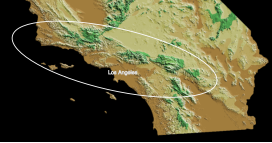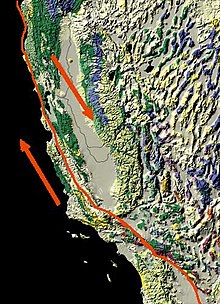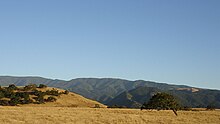Transverse Ranges
| Transverse Ranges | |
|---|---|
 The ellipse outlines the region of the California Transverse Ranges | |
| Highest point | |
| Peak | San Gorgonio Mountain |
| Elevation | 11,503 ft (3,506 m) |
| Coordinates | 34°05′57″N 116°49′29″W / 34.099162°N 116.824853°W |
| Dimensions | |
| Length | 300 mi (480 km) |
| Geography | |
| Country | United States |
| Parent range | Pacific Coast Ranges |
The Transverse Ranges are a group of mountain ranges of
The ranges extend from west of Point Conception eastward approximately 500 kilometers into the Mojave and Colorado Desert. The geology and topography of the ranges express three distinct segments that have contrasting elevations, rock types, and vegetation. The western segment extends to the San Gabriel Mountains and San Gabriel fault. The central segment includes mountains that range eastward to the San Andreas fault. The eastern segment extends from the San Andreas fault eastward to the Colorado Desert.[1] The central and eastern segments (near the San Andreas fault) have the highest elevations.
Most of the ranges lie in the California chaparral and woodlands ecoregion. Lower elevations are dominated by chaparral and scrubland, while higher elevations support large conifer forests. Most of the ranges in the system are fault blocks, and were uplifted by tectonic movements late in the Cenozoic Era. West of Tejon Pass, the primary rock types are varied, with a mix of sedimentary, volcanic, and metamorphic rocks, while regions east of the pass are dominated by plutonic granitic and metasedimentary rocks.[1]
Geography
This section needs additional citations for verification. (January 2021) |


The western and central segments of the Transverse Ranges are bounded to the north and east by the San Andreas Fault, which separates those segments from the Mojave Desert.[1][2] The eastern segment bounds the southern Mojave Desert. Notable passes along the San Andreas fault include Tejon Pass, Cajon Pass, and San Gorgonio Pass. Components of Transverse Ranges to the north and east of the fault include the San Bernardino Mountains, Little San Bernardino Mountains, Pinto and Eagle Mountains. The western and southern boundaries are acknowledged to be the Pacific Ocean and the northern Channel Islands. Onshore the Los Angeles Basin lies at the southern boundary of the western and central segments of the ranges. Major passes not along the San Andreas Fault include Gaviota Pass, San Marcos Pass, the Conejo Grade, Newhall Pass, and Cahuenga Pass.
The Transverse Ranges manifest themselves as a series of roughly parallel ridges with an average height of 3,000–8,000 feet (910–2,440 m). The ranges are dissected by young, steep streams of relatively low flow rate; as a result, there is high topographic relief throughout the range, and other than in marginal areas (e.g. the San Fernando Valley) and a few river valleys (such as Lockwood Valley and Big Bear Valley), there are no large, flat basins within the ranges.
The mountains are notable for being steep and difficult to traverse. There are few passes that are sufficiently low or wide enough to accommodate significant volumes of traffic. This has resulted in situations where major cities are linked to the rest of the state by relatively few roads; for example, the vast majority of traffic between the Central Valley and the Los Angeles area is routed through Tejon Pass. This results in significant traffic issues throughout Southern California when a pass has to be shut down due to heavy snow or construction. Occasionally, major cities, such as
Peaks
Major peaks of the Transverse Ranges with at least 500 feet (150 m) of prominence, listed by height:
- Mount San Gorgonio, 11,503 feet (3,506 m), San Bernardino Mountains.
- Anderson Peak, 10,840 feet (3,300 m), San Bernardino Mountains.
- Mount San Antonio (Old Baldy), 10,068 feet (3,069 m), San Gabriel Mountains.
- Sugarloaf Mountain, 9,952 feet (3,033 m), San Bernardino Mountains.
- Mount Baden-Powell, 9,407 feet (2,867 m), San Gabriel Mountains.
- Galena Peak, 9,324 feet (2,842 m), San Bernardino Mountains.
- Throop Peak, 9,142 feet (2,786 m), San Gabriel Mountains.
- Telegraph Peak, 8,985 feet (2,739 m), San Gabriel Mountains.
- Cucamonga Peak, 8,862 feet (2,701 m), San Gabriel Mountains.
- Mount Pinos, 8,847 feet (2,697 m).
- Ontario Peak, 8,693 feet (2,650 m), San Gabriel Mountains.
- Delamar Mountain, 8,402 feet (2,561 m), San Bernardino Mountains.
- Cerro Noroeste, 8,280 feet (2,520 m).
- Mount Islip, 8,254 feet (2,516 m), San Gabriel Mountains.
- Gold Mountain, 8,239 feet (2,511 m), San Bernardino Mountains.
- Bertha Peak, 8,205 feet (2,501 m), San Bernardino Mountains.
- Frazier Mountain, 8,017 feet (2,444 m).
- Iron Mountain #1, 8,010 feet (2,440 m), San Gabriel Mountains.
- Reyes Peak, 7,510 feet (2,290 m), Pine Mountain Ridge.
- Haddock Mountain, 7,431 feet (2,265 m), Pine Mountain Ridge.
Ranges
Western segment
This segment begins at Point Conception in Santa Barbara County, and include the
Central segment
The Ranges include the steep
Eastern segment
The San Bernardino Mountains, Little San Bernardino Mountains, and the Pinto, Eagle, and Orocopia Mountains are within the eastern segment. The Mojave Desert and California's low desert, including the Coachella Valley, are at the eastern end of the ranges.
Ranges north of the western segment that are nearly transverse but are part of the California Coast Ranges include the
Component ranges
|
Mountain ranges with peaks exceeding 4,500 feet (1,400 m), listed west to east, include: |
Examples of smaller mountain and hill ranges include:
|
Climate
The climate in most of the range is Csb (Warm-summer Mediterranean) under the Köppen climate classification; the upper reaches of San Gorgonio Mountain have an alpine tundra climate (ET), while the lower northern slopes of the range have a desert (BW) or steppe (BS) climate; most of the nearby lowlands to the south and west have a Hot-summer Mediterranean climate (Csa).[5]
Snow falls above 6,000 feet (1,800 m) most winters, and above 3,000 feet (910 m) every few years. It is rare for elevations above 8,000 feet (2,400 m) to go multiple winters without snow, even during severe droughts. Due to relatively low humidity, the regional snow line lies at about 14,000–16,000 feet (4,300–4,900 m), above the highest elevation of the range; as such, snow does not persist year-round except in the form of snow patches.
The tree line lies at about 11,000 feet (3,400 m); San Gorgonio Mountain is the only peak with an alpine environment.
| Climate data for Big Bear Lake, California, (1991–2020 normals, extremes 1914–present) | |||||||||||||
|---|---|---|---|---|---|---|---|---|---|---|---|---|---|
| Month | Jan | Feb | Mar | Apr | May | Jun | Jul | Aug | Sep | Oct | Nov | Dec | Year |
| Record high °F (°C) | 71 (22) |
72 (22) |
80 (27) |
82 (28) |
87 (31) |
98 (37) |
94 (34) |
93 (34) |
90 (32) |
85 (29) |
74 (23) |
70 (21) |
98 (37) |
| Mean maximum °F (°C) | 60.1 (15.6) |
60.3 (15.7) |
65.1 (18.4) |
72.2 (22.3) |
78.4 (25.8) |
85.8 (29.9) |
88.7 (31.5) |
86.5 (30.3) |
82.1 (27.8) |
75.5 (24.2) |
68.3 (20.2) |
61.8 (16.6) |
89.8 (32.1) |
| Mean daily maximum °F (°C) | 46.1 (7.8) |
45.7 (7.6) |
51.2 (10.7) |
57.3 (14.1) |
65.8 (18.8) |
75.1 (23.9) |
79.7 (26.5) |
78.7 (25.9) |
73.0 (22.8) |
63.4 (17.4) |
53.5 (11.9) |
46.2 (7.9) |
61.3 (16.3) |
| Daily mean °F (°C) | 34.3 (1.3) |
34.7 (1.5) |
39.1 (3.9) |
44.2 (6.8) |
51.5 (10.8) |
59.3 (15.2) |
65.1 (18.4) |
64.1 (17.8) |
58.5 (14.7) |
49.2 (9.6) |
40.6 (4.8) |
34.8 (1.6) |
47.9 (8.9) |
| Mean daily minimum °F (°C) | 22.7 (−5.2) |
23.7 (−4.6) |
27.0 (−2.8) |
31.0 (−0.6) |
37.2 (2.9) |
43.5 (6.4) |
50.5 (10.3) |
49.5 (9.7) |
44.0 (6.7) |
35.0 (1.7) |
27.8 (−2.3) |
23.5 (−4.7) |
34.6 (1.5) |
| Mean minimum °F (°C) | 9.1 (−12.7) |
9.8 (−12.3) |
14.1 (−9.9) |
20.1 (−6.6) |
27.0 (−2.8) |
33.4 (0.8) |
40.2 (4.6) |
39.3 (4.1) |
32.5 (0.3) |
24.5 (−4.2) |
15.4 (−9.2) |
10.1 (−12.2) |
4.9 (−15.1) |
| Record low °F (°C) | −25 (−32) |
−16 (−27) |
−12 (−24) |
−7 (−22) |
15 (−9) |
22 (−6) |
28 (−2) |
28 (−2) |
19 (−7) |
10 (−12) |
−15 (−26) |
−14 (−26) |
−15 (−26) |
| Average precipitation inches (mm) | 4.51 (115) |
4.39 (112) |
2.37 (60) |
0.78 (20) |
0.42 (11) |
0.15 (3.8) |
0.69 (18) |
0.82 (21) |
0.40 (10) |
0.79 (20) |
1.35 (34) |
3.31 (84) |
19.98 (508.8) |
| Average snowfall inches (cm) | 13.4 (34) |
14.3 (36) |
11.7 (30) |
3.0 (7.6) |
0.6 (1.5) |
0.0 (0.0) |
0.0 (0.0) |
0.0 (0.0) |
0.0 (0.0) |
1.2 (3.0) |
3.4 (8.6) |
11.0 (28) |
58.6 (148.7) |
| Average precipitation days (≥ 0.01 in) | 6.6 | 6.8 | 5.5 | 3.7 | 2.0 | 0.7 | 2.6 | 2.8 | 2.0 | 2.2 | 2.9 | 5.5 | 43.3 |
| Average snowy days (≥ 0.1 in) | 3.5 | 3.5 | 2.7 | 1.2 | 0.3 | 0.1 | 0.0 | 0.0 | 0.0 | 0.3 | 1.1 | 3.3 | 16.0 |
| Source: NOAA[6][7][8] | |||||||||||||
Geology
This section needs additional citations for verification. (January 2021) |


Tectonics
The Transverse Ranges result from a complex of tectonic forces and faulting stemming from the interaction of the Pacific Plate and the North American Plate along the dextral (right slip) San Andreas Fault system. Their orientation along an east–west axis as opposed to the general northwest–southeast trend of most California ranges results from a pronounced left step in the San Andreas Fault that occurred in the Pliocene (c. 4 million years ago) when southern reaches of the fault moved east to open the Gulf of California.[9] The crust within the Pacific Plate south of the ranges can not easily make the left turn westward as the entire plate moves northwestward, forcing pieces of the crust to compress and lift.
Prior to this shift of the fault to create the left bend, northwest–southeast trending rock belts in all of the Transverse Ranges began to rotate clockwise in the right shear of Pacific Plate – North American Plate motion.[10][11][12] This tectonic rotation began in Early Miocene Time and continues today.[13] The total rotation is about 90° in the Western Transverse Ranges and less (about 40°) in the eastern ranges.[14] Catalina Island shows the most rotation: almost 120°.[11]
A mechanism proposed for the rotation event is capture of the subducting Monterey plate by the outboard Pacific plate. Because the Monterey plate was then beneath southern California, the capture resulted in pulling of the overlying crust out and northward from the rest of California.[15]
Rocks
Rocks of the Transverse Ranges exhibit extreme differences in geologic age and composition, varying from sedimentary rocks in the western Santa Ynez and volcanic rocks in the Santa Monica Mountains to primarily granitic and metamorphic rock in the central and eastern segments, including the San Gabriel and San Bernardino Mountains.
The oldest basement (deepest) rocks are of
The western segment is distinctive for the large thickness of Cretaceous and Cenozoic sedimentary rocks, estimated to be up to 10 kilometers.[1] The thickest deposits of these are in the Santa Barbara Channel and Ventura basin. These are mostly marine in origin with a marked change to red beds of river systems of Oligocene age in the western and central segments.
Limestones and dolomites of the marine Miocene Monterey Formation are found in the Santa Ynez Mountains and in the Coast Ranges to the north.
Faults
Between the western segment and the Peninsular Ranges to the south is the complex Malibu Coast—Santa Monica—Hollywood fault, which exists as the border between these two mostly geologically unitary provinces.[16] These faults are part of the same thrust fault system south of the northern Channel Islands of San Miguel, Santa Rosa, and Anacapa Islands.[1] North of the western segment the bounding faults are left slip Santa Ynez and Pine Mountain Faults. The San Gabriel Fault and San Andreas bound the central segment. The eastern segment is bounded by the Pinto Mountain Fault in the north and the Salton Creek Fault in the south.
Petroleum
The large thickness of marine sediments in the western segment have made it a habitat for oil. Several dozen fields are found onshore and offshore, particularly in the Santa Barbara Channel and Ventura Basin. Much oil has pooled in the Monterey Formation, which is produced onshore and offshore. In the eastern Santa Barbara Channel oil is held in younger sedimentary rocks. The Los Angeles Basin south of the western segment, formed during rotation of that segment away from the Peninsular Ranges.[10] It is also a site of prolific oil production. The California Geologic Survey states:
Great thicknesses of Cenozoic petroleum-rich sedimentary rocks have been folded and faulted, making California one of the most important oil-producing areas in the United States.[17]
Ecology

The plant place of the Transverse ranges include
Chaparral is a common feature of the Transverse Ranges. Common plant associates in
Pinyon-juniper woodland is common on the north slopes of the San Gabriel and San Bernardino Mountains. This ecosystem is easily visible in the well-travelled Soledad Pass region, between Pearblossom and Santa Clarita.[citation needed]
Urban impact
A number of densely populated coastal plains and interior valleys lie between the mountain ranges, including the
Transportation
There are a number of important freeways that cross the Transverse Ranges, such as (from west to east) US-101,
See also
References
- ^ a b c d e f g Dibblee Jr, T.W., 1982. Regional geology of the Transverse Ranges Province of southern California. Geology and mineral wealth of the California Transverse Ranges, 10, pp.7-26.
- ^ a b c Norris, R. M.; Webb, R. W. (1990). Geology of California. Wiley.
- ISBN 978-0-8368-5282-0.
- ^ "California's Coastal Mountains". California Coastal Commission. Archived from the original on 2007-12-22. Retrieved 2007-12-25.
- ^ "Redlands Biology". Archived from the original on 2017-05-25. Retrieved 2014-10-21.
- ^ "NowData – NOAA Online Weather Data". National Oceanic and Atmospheric Administration. Retrieved July 3, 2013.
- ^ "Summary of Monthly Normals 1991–2020". National Oceanic and Atmospheric Administration. Retrieved August 20, 2022.
- ^ "xmACIS2". National Oceanic and Atmospheric Administration. Retrieved March 4, 2023.
- S2CID 31863250.
- ^ ISSN 0016-7606.
- ^ ISSN 0148-0227.
- ISSN 0016-7606.
- ISSN 0016-7606.
- ISSN 0016-7606.
- ISSN 0091-7613.
- ISBN 978-0-8137-2365-5.
- ^ ‘’California Geologic Provinces,’’ Note 36, page 2 Archived 2016-12-22 at the Wayback Machine
- A Natural History of California. Berkeley, CA: University of California Press.
- ^ C. Michael Hogan, (2008) Toyon (Heteromeles arbutifolia), GlobalTwitcher, ed. N. Stromberg Archived 2009-07-19 at the Wayback Machine
Further reading
- U.S. Geological Survey (1987). "Recent reverse faulting in the Transverse Ranges, California". USGS Publications Warehouse. Washington, D.C.: United States Geological Survey. doi:10.3133/pp1339. Retrieved September 19, 2020.
- Minor, S.A., Kellogg, K.S., Stanley, R.G., Gurrola, L.D., Keller, E.A. and Brandt, T.R., 2009. Geologic map of the Santa Barbara coastal plain area, Santa Barbara County, California: US Geological Survey Scientific Investigations Map 3001, scale 1: 25,000, 1 sheet, pamphlet 38 p.
External links
- Plio-Pleistocene Tectonic Shortening of the Transverse Ranges Archived 2017-11-17 at the Wayback Machine, block model animation by Tanya Atwater
